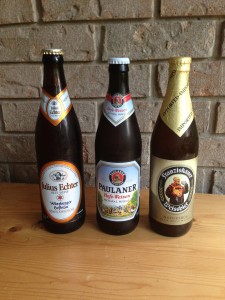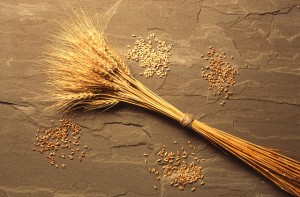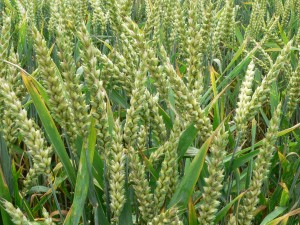India pale ale (IPA) is by far the most popular type of craft brew in the United States, and commercial brewers have responded by coming up with a variety of “spin-offs” of American IPA. One variation is wheat IPA, of which one of the earliest and most popular examples is Lagunitas’ Little Sumpin’ Sumpin’. The brewery describes it as “A filtered pale wheat ale that is great for both IPA and wheat beer fans.” Wheat IPAs combine the hoppy goodness of an American IPA with the crisp, bread-like, “zing” from an American-style wheat beer into one very tasty beer. (My wife loves the Lagunitas brew.) Here’s how to brew one at home.
Wheat
American wheat beers are usually around 50% barley malt and 50% wheat. (In contrast, the classic German hefeweizens are generally 30% barley malt and 70% wheat malt.) For a wheat IPA, pick any proportion you’d like, but expect lautering problems if you creep much over 70% wheat. For higher percentages of wheat malt, try crushing your barley malt a little more coarsely or adding rice hulls to the mash. [For a 100% wheat malt beer, you can try a brew-in-bag (BIAB) formulation, which obviates the need for lautering. James Spencer has done this for his 100% rye beer.]
You can use wheat malt, flaked wheat, torrefied wheat, or raw wheat in a wheat IPA. And, of course, wheat malt extracts — generally made from 50% barley malt and 50% wheat malt — are available. There are red and white wheat malts, and some brewers feel that red wheat malt — a favorite for German hefeweizens — gives better haze stability. White wheat malt is used in many American-style wheat ales, though. (For more on the differences between types of wheat, see this article on malts for German hefeweizens.)
Flaked or torrified wheat can be used for up to about 30% of the grist, although the proportion is usually much lower than this (around 10%) in practice. Flaked or torrefied wheat is most often used in conjunction with wheat malt, and either of these products can simply be stirred into the mash. The starches in them have already been “gelatinized,” and the enzymes from the other malts can convert them. [Incidentally, some folks (myself including) would argue that “gelated” is a better term for this, as gelatin is an animal product while gels come from plants. But I digress.]
If you use raw wheat, you’ll need to perform a cereal mash. In other words, you need to boil the wheat, along with about 5% malt, for at least 15 minutes and then stir this mixture into the main mash. Mix the raw wheat and malt with water to a thin mash consistency. In American wheat beers that use raw wheat, the percentage of raw wheat is usually around 5–10%.
Recipe Guidelines
A good starting point for any wheat IPA recipe would be either 50% barley malt and 50% wheat malt, or 50% barley malt, 45% wheat malt and 5% raw wheat. Do not use, or at least minimize the use of, crystal malts. Very small amounts of biscuit-type malts (including Briess Victory) or melanoidin/aromatic malts could be added to alter the flavor slightly. Your barley malt could be any 2-row pale malt, perhaps with a small percentage (less than 10%) of Vienna malt or Munich malt thrown in. In my opinion, this type of beer doesn’t benefit from an overly-complex grain bill.
There are no style guidelines for wheat IPA, so you can brew it to any strength you want. American-style wheat ales can be as low as 10 °Plato (OG 1.040), while American IPAs range up to almost 19 °Plato (roughy OG 0.176). So, you’ve got a wide range to work with.
Hops and Yeast
You can port over your favorite hop blend from your regular IPA or come up with something similar. If you’re going to call the beer a wheat IPA, you’ll probably want to get the IBUs at least up to 40. However, if you want the wheat to come through more strongly, you might hop this less than you would a regular IPA, especially if the OG is more in line with an American wheat beer than and American IPA.
Although you could brew a wheat IPA fermented with a German hefeweizen yeast strain, the wheat IPAs produced by American breweries are fermented with relatively neutral ale strains, as would be appropriate for either an American wheat beer or American IPA. If you did use a German hefeweizen strain, you’d need to increase the amounts of bittering hops as these yeasts yield less bitter beers, compared to beers fermented with other yeasts.
Haze

A wheat IPA does not have the banana and clove aromatics of a German hefeweizen, but it may have a similar level of haze.
Once you’ve settled on a wheat beer base and a hop schedule, you would brew this beer as you would any other IPA. Your biggest concern is going to be the higher levels of proteins (from the wheat) and tannins (from the hops), both of which contribute to haze.
Wheat malt usually contains 13–14% protein, compared to barley malt, which should be under 12%. A good, hard, 90-minute boil will help coagulate much of the excess protein into hot break. A little haze is, of course, acceptable — even desired — in a wheat beer. Too much, however, contributes to biological instability.
You’ll be better off waiting until you see the hop break before you add your first charge of hops to the kettle. If you’d like to minimize haze, don’t be afraid to increase the dosage of Irish moss to around 1.2 tsps. per 5 gallons (19 L).
Proteins and tannins interact whenever they are present in an aqueous solution (including wort and beer). In a wheat IPA, dry hopping can lead to an increase in chill haze, the haze that appears when the beer is cold. Interestingly, some protein-tannin complexes are anti-oxidants, so a little haze can actually protect your beer from spoilage.
In dry hopped beer, the protein-tannin complexes formed in the cold beer are initially small (involving only few subunits linked together). Many of them are too small to cause haze. However, oxidation of these complexes adds color to the beer and transforms the chill haze into permanent haze. Oxidation polymerizes these complexes, joining them together in a chain. The larger, polymerized proteins and tannins are large enough to scatter light and cause haze. Therefore, be careful not to introduce oxygen into your beer when dry hopping. This can occur easily when dry hopping with whole hops. Purge them with CO2 before use to minimize this problem.
The hop character in hoppy beers tends to fade with time. Likewise, in a purposely hazy beer, the haze can change. For both these reasons, wheat IPAs are best enjoyed fresh. They do not make good candidates for cellaring.
—-
Related articles



Speak Your Mind